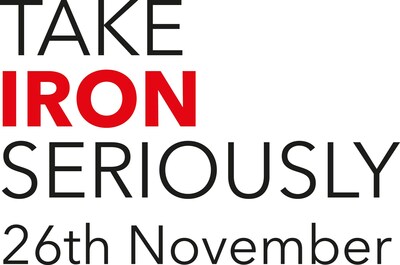Iron Deficiency Day unites a strong global coalition raising awareness on the serious health impact of iron deficiency and iron deficiency anemia1
This year, the spotlight is on the importance of early iron deficiency diagnosis and treatment and its impact on quality of life
ST. GALLEN, SWITZERLAND, Nov. 24, 2023 /PRNewswire/ -- This Sunday, 26 November, marks Iron Deficiency Day, a day dedicated to raising awareness about the importance of diagnosing and treating iron deficiency and iron deficiency anemia. Supported by an alliance of international patient organizations and health advocacy groups, CSL Vifor takes a leading role annually to educate people about the importance of iron for the body and what can happen if iron levels are not properly managed. It encourages people to become better informed and to seek medical advice from their physicians.
"Iron Deficiency Day stands as a mainstay of our ongoing commitment to underscore the significance of taking iron seriously", said Hervé Gisserot, General Manager CSL Vifor. "Despite the serious consequences and high prevalence of iron deficiency, the condition remains under-recognized. At CSL, we are driven by our promise to patients around the world and together with our partners, we are committed to further building awareness, helping patients recognize their symptoms, and improving access to care."
Although iron deficiency affects one in three people worldwide2, it is most prevalent in premenopausal women, pregnant women, and children under five3. However, early access to diagnosis and treatment remains a challenge. Disparities in gender4, educational status4,5 and geography5 are just some of the many aspects that may further limit access to information, diagnosis, and medical support. To address this unmet need, CSL Vifor raises awareness of iron deficiency and iron deficiency anemia across Europe, South America, the Middle East, Asia and Australia.
"Iron deficiency affects about half of the patients suffering from chronic kidney disease. However, geographic and socio-demographic barriers often prevent many patients from receiving a timely diagnosis", commented Daniel Gallego, President of the European Kidney Patient's Federation. "As iron deficiency and iron deficiency anemia is easily diagnosed and treatable, it is crucial that every individual has access to resources for understanding the condition, to benefit from early diagnosis and treatment regardless of their background or circumstances. As ultimately this could lead to improved quality of care and life of those living with CKD."
Iron Deficiency Day is endorsed by multiple international organizations including the Heart Failure Policy Network, European Kidney Health Alliance, Global Heart Hub and Croí the West of Ireland Cardiac Foundation.
CSL Vifor encourages the global community to join and raise awareness on iron deficiency by promoting education and early intervention. To learn more about the importance of equity, early diagnosis and recognizing symptoms of iron deficiency, visit www.takeironseriously.com. Use hashtags #TakeIronSeriously and #IDDay2023 on X (Twitter) and LinkedIn.
About CSL Vifor
CSL Vifor is a global partner of choice for pharmaceuticals and innovative, leading therapies in iron deficiency and nephrology. We specialize in strategic global partnering, in-licensing and developing, manufacturing and marketing pharmaceutical products for precision healthcare, aiming to help patients around the world lead better, healthier lives. Headquartered in St. Gallen, Switzerland, CSL Vifor also includes the joint company Vifor Fresenius Medical Care Renal Pharma (with Fresenius Medical Care).
The parent company, CSL (ASX: CSL; USOTC: CSLLY), headquartered in Melbourne, Australia, employs 32,000 people and delivers its lifesaving therapies to people in more than 100 countries. For more information about CSL Vifor visit, www.cslvifor.com.
Notes to Editors
Takeironseriously.com is intended to provide educational information to an international audience outside the US; it is available in 17 languages. All information on the site is intended for educational purposes only and should not be used to replace a discussion with a healthcare professional. All decisions regarding patient care must be handled by a healthcare professional and be made based on the unique needs of each patient.
About iron deficiency
Iron plays a vital role in many bodily processes, including the production of red blood cells, effective heart and brain function, and the prevention of infection and illness. Without enough iron, the body is unable to function properly. Common symptoms include fatigue, dizziness, and shortness of breath. Iron deficiency and iron deficiency anemia is estimated to affect one in three people worldwide6, yet despite the serious consequences and high prevalence7, it remains an under-recognized condition.
The effects of iron deficiency differ from person to person but can be linked to an overall decline in general health and well-being8. Even without anemia, iron deficiency can be debilitating, exacerbate an underlying chronic disease and lead to increased morbidity and mortality8. Common symptoms include fatigue8,9,10 pale skin9, brittle nails9, 11, craving non-food items such as dirt, clay and ice12, and an inability to concentrate8, 13. In children, iron deficiency can significantly impair cognitive and motor development14.
Left untreated, iron deficiency can develop into iron deficiency anemia. Multiple organizations, including the World Health Organization (WHO), UNICEF and the U.S. Agency for International Development (USAID) have called for a comprehensive anemia monitoring framework. Find more information on the global burden of anemia in the report published in the Lancet in July 2023: https://pubmed.ncbi.nlm.nih.gov/37536353/. .
References
- Hassan, Tamer Hasan et al. "Impact of Iron Deficiency Anemia on the Function of the Immune System in Children." Ed. Esaki M. Shankar. Medicine 95.47 (2016): e5395. PMC. Web. 12 June 2018.
- Vos, T., et al. Global, regional, and national incidence, prevalence, and years lived with disability for 310 diseases and injuries, 1990–2015: a systematic analysis for the Global Burden of Disease Study 2015. The Lancet, 388(10053), 1545–1602.
- Hercberg S, et al. Iron deficiency in Europe. Public Health Nutr. 2007;4(2b).
- Alfadhul S, Kadhum S. The significance of awareness about iron deficiency anaemia in its prevention among Iraqi pregnant women attending primary healthcare centres. Family Medicine & Primary Care Review. 2023;25(3):250-255. doi:10.5114/fmpcr.2023.130084.
- Safiri, S., Kolahi, AA., Noori, M. et al. Burden of anemia and its underlying causes in 204 countries and territories, 1990–2019: results from the Global Burden of Disease Study 2019. J Hematol Oncol 14, 185 (2021). https://doi.org/10.1186/s13045-021-01202-2.
- Peyrin-Biroulet L, et al. Guidelines on the diagnosis and treatment of iron deficiency across indications: a systematic review. Am J Clin Nutr. 2015;102(6):1585-94.
- World Health Organization. Worldwide prevalence of anaemia 1993-2005. 2008. Available at URL: http://apps.who.int/iris/bitstream/handle/10665/43894/9789241596657_eng.pdf;jsessionid=9C613E2F4D481EDEB9DE07986AFC E0C7?sequence=1. Last accessed: November 2023.
- Fernando B, et al. A guide to diagnosis of iron deficiency and iron deficiency anemia in digestive diseases. World J Gastroenterol. 2009 Oct 7; 15(37): 4638-4643.
- Auerbach M, Adamson JW. How we diagnose and treat iron deficiency anemia. Am J Hematol. 2016;91(1):31-38.
- Favrat, B., et al. (2014). Evaluation of a single dose of ferric carboxymaltose in fatigued, iron-deficient women--PREFER a randomized, placebo-controlled study. PLoS One 9(4): e94217. eCollection 2014.
- Cashman MW, Sloan SB. Nutrition and nail disease. Clin Dermatol. 2010;28(4):420-5.
- Barton JC, et al. Pica associated with iron deficiency or depletion: clinical and laboratory correlates in 262 non-pregnant adult outpatients. BMC Blood Disord. 2010;10:9. doi:10.1186/1471-2326-10-9.
- Patterson A et al. Iron deficiency, general health and fatigue: Results from the Australian Longitudinal Study on Women's Health. Qual Life Res. 2000;9:491-497.
- World Health Organization. Nutritional anaemias: tools for effective prevention and control. 2017. Available at URL: http://www.who.int/nutrition/publications/micronutrients/anaemias-tools-prevention-control/en/. Last accessed: November 2023.
SOURCE Vifor International AG (CSL Vifor)






